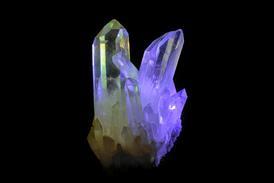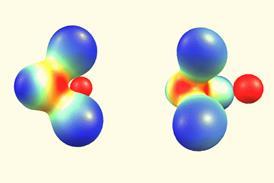Reactions and synthesis
-
 Research
ResearchLight-driven enzyme engineered and repurposed to catalyse unnatural reaction
Directed evolution used to create photoenzyme that can perform new-to-nature radical cyclisation
-
 Research
ResearchCould mechanochemistry have saved Abbott Laboratories $250 million?
Ball milling solves problem of disappearing ritonavir polymorph
-
 Research
ResearchTelling left from right: chirality detection faces up to its weaknesses
New solutions are being found to an enduring problem in chemistry
-
 Research
ResearchAnalysis of three French chemistry labs shows how they could halve their carbon footprint by 2030
Open-source tool helps researchers evaluate a series of carbon mitigation strategies
-
 Research
ResearchFirst mirror-image cyclodextrins come together ‘like Lego’
L-enantiomers could be more stable than their existing, more common, forms
-
 Research
ResearchCrystalline cages create unusual ‘touchless’ sensors
Researchers connect chemistry and engineering to create touch-free buttons based on the detection of the skin’s water
-
 Research
ResearchCross-coupling technique cracks open alcohols for chemical synthesis
A new alcohol–alcohol cross coupling reaction could become a powerful new tool for synthetic chemists
-
 Research
ResearchMolecular crystal motors completely powered by light
Chemists in Saudi Arabia and the US have created tiny machines made from crystallised molecules that continuously move when exposed to light
-
 Research
ResearchDIY recycling protocol could save organoiridium waste from incinerators
‘A very good solution to solve a niche problem’
-
 Research
Research3D-printed capsules enhance speed and safety of synthetic chemistry
Encapsulated reagents allow chemists to ditch their Schlenk line to synthesise ferrocene
-
 Research
ResearchEnergetically unfavourable Diels-Alder reaction driven by chemical fuel
Carbodiimide fuel powers rare, thermodynamically unpromising reaction between diene and dienophile
-
 Research
ResearchPorphyrin ribbons transport charge with no resistance
Molecules could form the basis of ‘perfectly transmissive’ molecular wires
-
 Research
ResearchBad habits obscuring thermodynamic reality of photocatalytic reactions
Dubious assumptions and contentious nomenclature muddying the literature
-
 Research
ResearchSodium lumps, glucose and mechanochemistry behind ammonia-free Birch reduction
Protocol solves ‘malleability problem’ of activating alkali metals like sodium
-
 Research
ResearchEnzyme engineering makes blue denim greener
Environmentally friendlier alternative to indigo dye can now be made at a competitive price
-
 Research
ResearchClassic cross-coupling reactions rerouted to make new products
Combination of Suzuki–Miyaura and Buchwald–Hartwig couplings produces carbon–nitrogen–carbon linked compounds
-
 Research
ResearchBoron cluster family breaks electron counting rules
Rare structures have unusual deltahedral shapes
-
 Research
ResearchMachine learning could ‘change the paradigm’ for polaritonic chemistry
Model reveals influence of vibrational strong coupling during light-driven reaction
-
 Research
ResearchIron salts catalyse the creation of carbenes for cyclopropanation
A new strategy to synthesise non-stabilised carbenes gives access to cyclopropanes with potential in drug discovery
-
![[Br4F21]- index image](https://d2cbg94ubxgsnp.cloudfront.net/Pictures/100x67/1/7/3/532173_br4f21indeximage_49094.jpg) Research
ResearchUnusual bridging fluorine discovered in one-of-a-kind interhalogen ion
Similarity to MgAgAs crystal structure takes researchers by surprise


